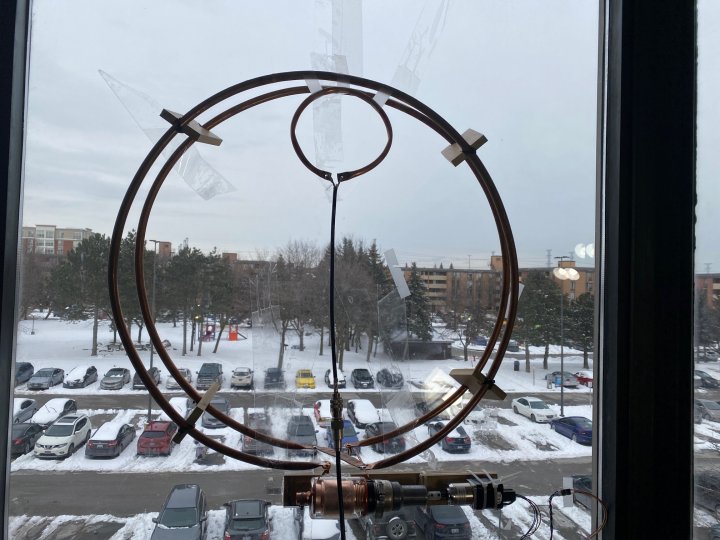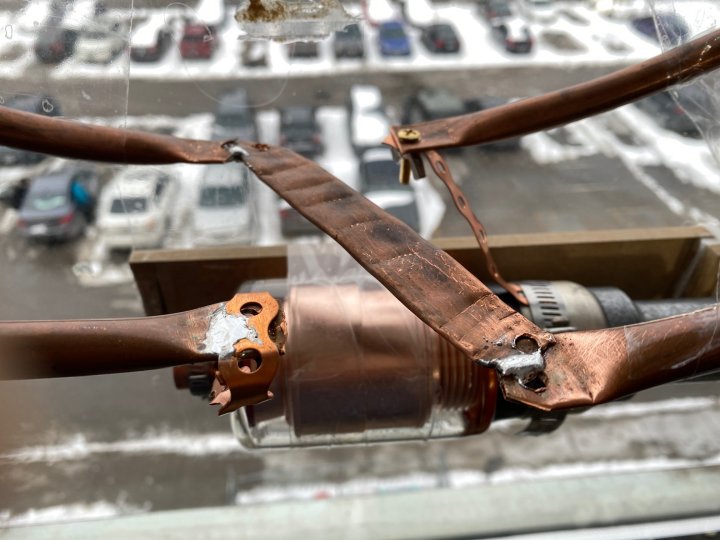VE3GVW Doug
Magnetic Loop
2nd March 2020
![]()
The Magnetic loop antenna.
"Small magnetic loop antennas respond to the complimentary magnetic component of radio waves."
My interest in mag loop antennas was born out of my
interest in operating on HF
even though I only had the limited space of a 3 bedroom
apartment. I tried mag sticks
on the balcony , dipoles , end fed antennas ect in
the apartment with little or no success.
What i needed was an antenna for limited space that
worked. I went through the Antenna handbook
but all the limited space antennas didn't seem to
suite my situation.
I had heard of Magnetic loop antennas and saw a couple
of store bought ones
but the idea of paying Big dollars for an antenna
basically made out of coax
didn't appeal to me. I bought an MFJ "Loop Tuner"
and an MFJ antenna made
to use with their "loop Tuner" with mixed results.
The wire provided for the
loops was only 10 guage which is far too small
so I decided to try some copper tubing.
I got 3/8' tubing and tried a few loop diamater's
recomended in the "Loop tuner" manual
and the reception was alot better although i
never made any contacts. Loop diamater's
larger than 6 feet didn't seem practical coupled
with the limited size of the capacitor
in the "Loop tuner. What i needed was a stand
or hanger of some sort for the tubing.
There are many different designs , sizes of loops
and materials to hold them together.
PVC seemed to be the most popular to hold the loops
together and the loops were either
coaxial cable or copper tubling. I came across
a video by Jeri Ellsworth AI6TK who was
making a series of Utube videos on the design
and construction of mag loop antennas but
never went further than the first video. The stand
for her copper loops were made outof plywood
and 2x4's which made all the other ones look pale
in comparison. I went out got some plywood.
2x4's and delrin to support the loops because
of the high voltage. Putting the copper loops
on this design made as much sense as puting
a coat on a hanger.
For my "mag loop mini" to be practical in an
apartment a 6' loop seemed a little large.
The local hardware store would have to special
order 3/4" copper tubing but the minimum
was 50' (ouch). Since 25' worked fine for 80
meters on my big loop i got 25' of 5/8' tubing.
To make the antenna smaller i made 2 12.5' circumference
loops which works out to 4' diamater.
For 80 meters the 2 parallel loops are connected
in series ( 25' ) and for 40 meters
they are connected in parallel. Both configurations
had to work with a 30-300 pf vacuum variable
capacitor across both bands. Both 80 & 40 meters
can be tuned with the loops in series however
the "Q" on 40 meters will only be 550 instead of 1500
when connected in parallel. The loss on 80
meters compared to a "DIPOLE" is -7.5 dB or
1.25 "S" units. On 40 meters when connected in parallel
(which equals 1.25" tube) the loss is -4.7 dB or less
than 1 "S" unit. The tubing size is very
important to keep the resistance as low as possible
given the "skin effect" increases with frequency.
Remote tuning of the capacitor is a "must" for this
type of antenna.
Kevin Laughton KB9RLW has youtube videos including
one on his
remote control design with just a few parts.
![]()
The link below is an introduction to the magnetic
loop antenna and is well worth reading.
![]()
Doug VE3GVW






New 40 meter 2 foot Mag Loop
First contact: 1200 km to Moncton Nb
2 foot dia double loop in series for 12.5’ of 1/2” copper
tubing , 10% wavelength on 40 meters.
A strong signal was heard on a Moncton Nb Sdr remote
.( and many others )
Worked 2 Ontario hams through rx only remote.
Doug VE3GVW





Questions:
Check out Doug's QRZ.COM page...click above.
![]()
This Link Page specially created by:


